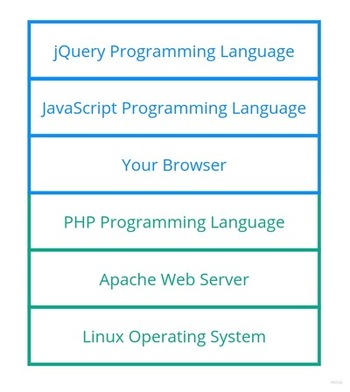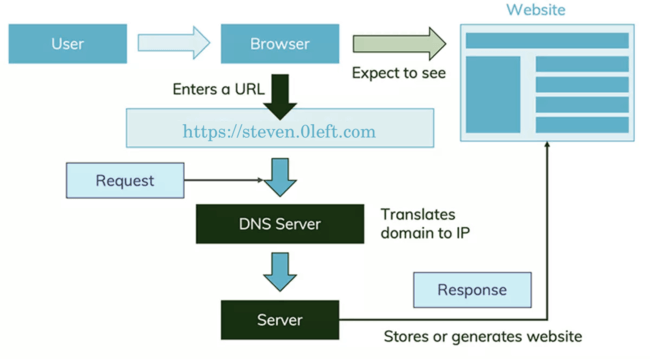The Truth About Full Stack Developers
Before revealing the truth about Full Stack developers, we first need understand what a stack is or rather, what is included in a stack. As we will soon see, the beginning and end of a stack is not always well defined. But, don’t let that scare you. In this Technology Explained article, we will help you understand and choose between Front-End vs Back-End vs Full Stack, without an ounce of stress.
Key Takeaways
- Programs, like the universe, are made up of building blocks
- A stack is a collection of blocks
- What you see is Front-end and what you don’t is Back-end
What We’ll Talk About
- The Wonderful Universe We Call Home: It’s all connected – trust me
- How This Website Stacks Up: A peak behind the scenes
- To What End(s): Where does the stack begins and ends, and what is the Full-Stack
- Who To Hire? Front, Back or Full: The truth about the Full-Stack super hero
The Wonderful Universe We Call Home

You might be wondering what the universe has to do with stacks and ends. Don’t run away just yet. You’ll find that programs and the computers they run on are not that complicated once you can relate their complexities to something you already understand – like the Universe.
Alright, maybe the Universe is not that simple but in the next 5 minutes, we’ll use it to explain Front-End vs Back-End vs Full Stack. And, you’ll walk away with something to talk about at the next company retreat.
The wonderful Universe we call home is made up of large and small things. And, even smaller, and smaller things. It’s a beautiful and elegant construct that perhaps we may never truly understand but, we are certain about one thing. The large is made up of the small and the small is made up of the smaller and so on.
You are made up of molecules that stuck around long enough to make “you” possible. And, those molecules – they’re made up of smaller components we call Atoms which are made up of even smaller components we call Quarks.
Combine enough stuff together and we get “you”. The very unique and special “you”.
Actually. You aren’t that unique – You still exist as a collection of common building blocks, just like me. And my website unfortunately isn’t that unique either. It too is made up of common building blocks sprinkled with my own personal touch.
Programs are stacked on top of other programs, stacked on top of other programs. Combined, this is a stack and it is selected out of the Universe of possible building blocks, we call technology.
How This Website Stacks Up
Let’s have a closer look at this website to elaborate on this idea of a “stack”.
Here, I get to play God but, even so, I am limited by the blocks that are available to me and by what those blocks can do. Without a building block that allows a virtual “me” to appear in front of you, reading this article out-loud, I’m afraid you’ll have to simply make due by imagining my voice to be that of Morgan Freeman.
My website stack looks a little something like this;

Blue, representing Front-End. Green, representing Back-End
Front-End

The part of this website that you get to see is called the Front-End.
I use a language called jQuery to express (program) my desires. It, in turn, uses JavaScript and a Browser to represent my commands onto the screen you are currently reading. But, that’s not the whole story. While Front-End technology can handle presentation it is not well suited to handle the substance itself – the data.
Back-End

The part of this website that you don’t see is called the Back-End and that is where this article’s content actually lives.
The Front-End (via an API – Application Programing Interface) asks the Back-End for the article’s content so that it can present it to you in an appealing fashion.
I wrote my Back-End instructions in PHP which gets interpreted by an application called Apache, which runs on an Operating System called Linux. (If the term Operating Systems is tripping you up, just know that Linux is a type of Operating System like Windows and Mac OS). It is the program that provides my Front-End with the article content.
Full-Stack

A Full-Stack developer is what we call someone who knows how to program using Front-End technologies and Back-End technologies. It is generally recognized that a Full-Stack is someone who can essentially deliver this entire website (for example).
Hey – Simple enough!
Um – Not exactly.
Searching for a Full-Stack definition will give you varying results. That's because not everyone agrees where the "ends" actually end. If we don't agree on the ends, we won't agree on what "Full" means.
To What End(s)
The problem with Full-Stack is that many people interpret it differently. The illustration above only shows a few of the technologies needed to present this article to you. Truthfully, its a bit more complicated.
Let’s have a closer look

All I’ve done in the illustration above is add 1 more element to the stack and we can already see the stack complexity growing. Whether you clicked on a link or entered in this article’s address directly into your browser’s search box, some magic had to happen for your browser to locate my site. This magic is called DNS (Domain Name System) and it one more component that must be addressed before a website can be delivers to you. And their are more… many more.
So, what does/should Full-Stack include as its definition?
It depends who you ask but for the sake of offering you closure, lets simply state that :
Full-Stack represents someone who can program the Front-End and Back-End of your application excluding any supporting technology that might be needed to run it.
Be aware however, that if you search for a definition of Full-Stack, you will get varying definitions. I can only offer you the one that I believe to make most sense.
Summarizing The Question Of Front-End vs Back-End vs Full Stack

We can see many things in our Universe but none of it would be possible without the things we can’t see. Those invisible building blocks are our Universe’s Back-End and that beautiful flower growing in the spring is our Front-End.
Much like our Universe which can be divided over and over until we get to the tiniest of building blocks, such is technology. And, at its most fundamental level, we find electrons pulsating as ones and zeros, telling computers how to serve us.
Computers may not be as complex as our Universe but hopefully, you can now walk away understanding a bit more of both.
Who To Hire? Font, Back or Full

Front-End developers tend to have very different personalities than Back-End. In-fact, this difference was probably the biggest catalyst to Front-End and Back-End becoming a thing.
Front-Ends like colors and pictures and making things visually appealing. They’re passion is the User Experience (UX).
Back-Ends tend to be less artistic (visual arts) and more structured and substance based.
If this was an article about building architecture, we could explain the difference as Form vs Function. The Front-End developer wants it to look good above all else while the Back-End developer wants it to function well above all else. In this explanation, you will find the foundation of my answer.
Answer
If you want a very appealing and highly functional result – hire Front-End and Back-End developers.
If you want something that lacks in appeal and/or functionality but serves your goals – hire a Full-Stack
Hopefully, this article helped you grasp the differences between Front-End vs Back-End vs Full Stack and provided you with some useful information to help you decided if you’re looking for specialists or jack of all trades.
Do you disagree with my definition of Full-Stack? I love a good debate and want to hear from you. Reach out to me on LinkedIn and mention this article.
